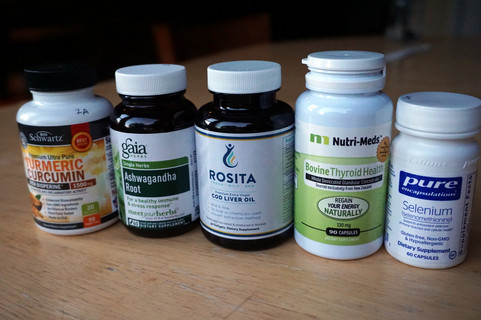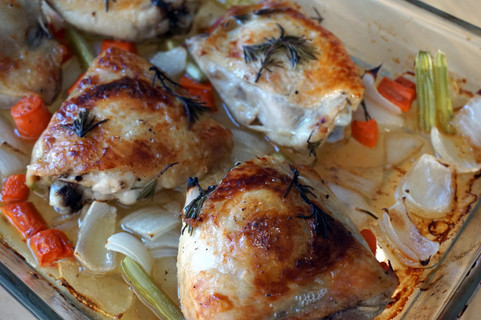My Husband's Autoimmune Healing Diet
- Sarah

- Jun 30, 2019
- 5 min read
Updated: Sep 17, 2023
Conventional treatment of autoimmune disease usually involves steroids and other immunosuppressive drugs. These drugs do nothing to fix the underlying autoimmunity and are accompanied by a long list of potential adverse effects...
A Functional Medicine approach to autoimmune disease, on the other hand, seeks to identify why autoimmunity is occurring in the first place and address these underlying causes. A crucial piece of this treatment approach is finding the right diet.
Our First Steps
When my husband Ryan's health took a rapid downward spiral back in November and December 2018, dietary changes were among the first things we implemented to try to get a handle on everything. We did not yet know that Ryan had autoimmune disease, but we knew that something had to change, quickly.

He started with a 9-day raw milk fast (using almost completely raw milk kefir) in January 2019, based on The Milk Cure. The milk kefir fast did seem to help with getting Ryan's symptoms somewhat calmed down, but it was by no means a miracle cure. He started losing weight on the milk kefir diet because he couldn't bear to choke down any more of it; given that he is chronically underweight, this couldn't continue and so we decided to implement the GAPS Introduction Diet.
Although my family had very mixed results with the GAPS Diet years ago, we were desperate enough that we decided to use it temporarily to identify food triggers that worsen Ryan's condition. The GAPS Diet focuses on healing the gut through a nourishing diet of healthy fats (such as ghee and coconut oil), meats, organ meats, fruits, veggies, broth, and fermented foods. The GAPS Diet does not allow any grains or starches, and allows no sweeteners except honey. The GAPS Intro Diet is an even more extreme form of the diet, which starts with a very limited diet and slowly introduces foods one at a time.
We had already figured out that Ryan had intensely bad reactions to pork, and in the past he had sometimes reacted badly to beef, so his initial GAPS Intro Diet was based largely around chicken soup, chicken liver, vegetables cooked in ghee, avocados, milk kefir, and extra-virgin cod liver oil. Some food reactions were noted with green beans and pumpkin, and we realized we needed to proceed very slowly and carefully with introducing any new foods.
Autoimmune Paleo Combined With GAPS Diet
When my husband got his Hashimoto's diagnosis, and we finally realized that he was suffering from psoriasis (and not eczema), I got to work on researching diets that can help with these autoimmune diseases.
My husband is currently following a combination of the Auto Immune Paleo (AIP) dietary protocol and the GAPS Intro Diet to aid in healing his autoimmune diseases. That means he is currently eating no grains, legumes, dairy, nuts, eggs, starches, nightshades (potatoes, peppers, tomatoes), seeds (including many spices), soy, or sweeteners (except honey in very small amounts).

My husband also has a sensitivity to pork, and has a suspected sensitivity to beef! Many of the healthy foods our family usually eats are not going to work for my husband right now. Instead, Ryan's diet is focusing on healthy fats (such as coconut oil, duck fat, and chicken fat) grassfed/pastured meats, organ meats, vegetables, broth, and fruits.
NOT Aiming for Low Carb
There is some evidence that low-carb diets are not good for people with thyroid or adrenal problems. Although it is difficult with such a restricted diet that includes no starches or grains, we are purposely trying to make sure Ryan's diet includes more carbs. So we are trying to regularly include higher-carb vegetables such as butternut squash, and he is eating a bit more fruit than he would otherwise.
Diet Isn't THE Cure
There are lots of anecdotal stories of people whose autoimmune disease was pushed into remission just through diet changes (such as going gluten-free). That hasn't been the case for Ryan, probably because he has already been eating a nutrient-dense, low grain diet for nearly a decade. I suspect that someone who was eating the typical American diet of processed foods and junk foods would see a much more marked improvement from implementing the GAPS or AIP diet.
Diet alone isn't the cure-all for my husband, but it does help alongside the other therapies we are using (including homeopathy, adaptogenic herbs, bovine thyroid, extra-virgin cod liver oil, Vitamin D3, selenium, turmeric, and other supplements, plus lifestyle changes such as increasing his sleep, gentle exercise, regular sun exposure, and stress reduction). Although my husband's dietary changes have not lead to any strong obvious improvements, when he deviates from this diet he can have strong bad reactions (such as when he tried consuming an almond flour muffin, or white navy beans which are GAPS legal). The diet isn't *curing* him, but it is helping to keep his symptoms at a more manageable level.
What He Eats
Within the framework of Ryan's severely-restricted diet, I'm trying to find plenty of meal options so he isn't eating the same things over and over and over. This is especially challenging because of his sensitivities to pork and probably beef! Currently, the foods he's eating most often are as follows:
Breakfast
Ryan's stomach doesn't react well to hearty meals first thing in the morning, so these are intentionally lighter on his digestion.
Homemade applesauce with added coconut oil and/or coconut manna
Green smoothies with ingredients such as spinach, zucchini, roasted butternut squash, banana, mango, lime, blueberries, apple, basil, and/or coconut manna
Lunch
These meals are made from frozen leftovers, which are reheated in a toaster oven.
Chicken soup with giblets, carrots, onions, celery, zucchini, etc
Roasted chicken thighs with onions and carrots
Chicken and mushroom soup
Snacks (2-3/day)
Banana with coconut manna
Dehydrated zucchini chips
Leftover green smoothie
Freeze-dried fruit with coconut manna
Dinner
I double most of these recipes so that we can freeze leftovers (in glass containers) to take to work for lunch.
Salads topped with chicken, avocado, sauteed mushrooms, caramelized onions, etc, and dressed with homemade Italian vinaigrette
Chicken soup with giblets, carrots, onions, celery, zucchini, often with half an avocado on top
Chicken liver and caramelized onions, with cooked carrots and avocado
Rosemary and lime roasted chicken thighs with onions and carrots, sauteed mushrooms, sauteed zucchini and onions,, etc
Salmon or cod fish with sauteed veggies and avocado
Chicken and mushroom soup (based on this recipe, but without the vermouth, arrowroot/flour, or sour cream)
It Won't Last Forever
This diet isn't meant to last forever. We are using the GAPS/AIP dietary protocol as a temporary measure to help get my husband's symptoms into remission. Our top priority now is getting him able to live a full life, instead of one severely limited by physical pain,suffering, and fatigue. Once that is achieved, we'll be systematically adding back healthy foods such as eggs, ghee, starches, and raw milk kefir.
Have you had success with treating chronic conditions through diet and nutrition?
Links to Amazon and Corganic are affiliate links. If you use these links, your price remains the same but I may earn a small commission. Thanks for supporting this site!



















Comments